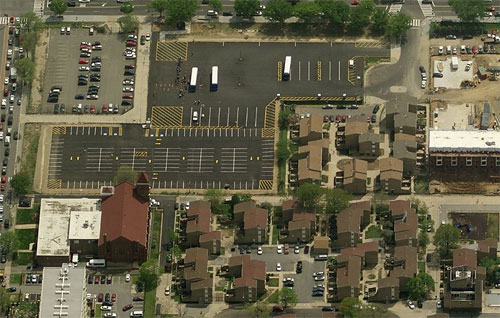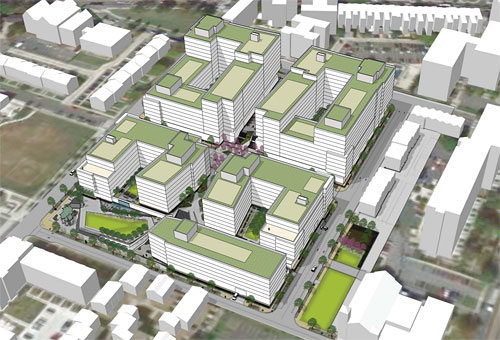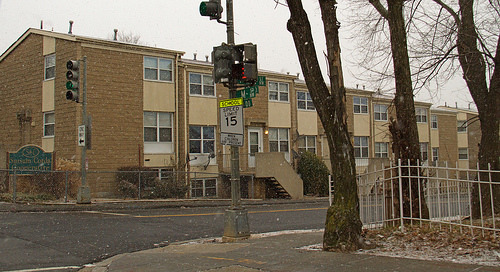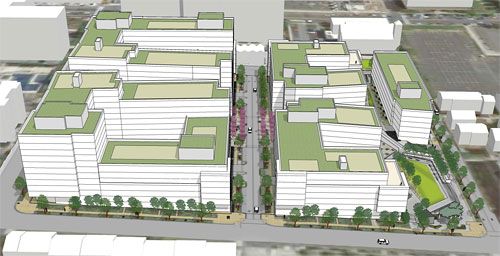A NoMa cooperative hopes to redevelop mixed-income housing more successfully than DC’s past attempts
A 1968 experiment in cooperative low-income housing near DC’s NoMa neighborhood will soon be the site of a large redevelopment project. The owners plan to add new apartments and retail while preserving places to live for current residents of the community.
Sursum Corda (Latin for “lift up your hearts”) lies along First Street NW between L and M streets. It was built by religious organizations using a federal Housing and Urban Development loan to provide homeownership opportunities for low-income residents. A series of townhouses surrounded a U-shaped road.
This inward focus, the designers hoped, would create a sense of community, but as urban disinvestment set in and crime rates rose amid the crack epidemic in the 1980s, the layout attracted drugs and gangs. A high-profile shooting in 2004 in the nearby Temple Courts apartments jump-started discussions about redeveloping the complex.
The current buildings contain 199 housing units; when complete, both phases of the proposed new project will have 1,142 units. There will still be 199 units set aside for lower-income residents, 143 of whom are current residents.
What’s in the project
The 6.7-acre project will happen in two phases, the first on the L Street side and then a second phase to the north. The land is about 25 feet lower on the south side, and the buildings will also be shorter to match the existing church and smaller apartment buildings on that side.
The new buildings will include ground-floor retail on M Street and some small spaces that might become retail on L. The project will also renovate public park at the corner of First and L. The zoning filings do not yet specify how many bedrooms there will be in the various units.
Pierce Street to the west of this block will extend through the new project dividing the complex east-west, and a pedestrian walkway in the middle will run north-south. First Place, which is currently one leg of the U-shaped interior road, will extend all the way to L, while the other two legs of the U will disappear.
The architecture (such as we can see so far from the very rough early renderings) is modern, with a variety of angles, but otherwise adapts the fairly traditional style of U-shaped or donut-shaped apartment buildings surrounding courtyards.
Plans call for 848 parking spaces, 341 in the first phase and 507 in the second, which is probably an unnecessary amount of parking for apartments so close to downtown and the Metro. The zoning only requires 286 spaces. The proposal includes 453 bicycle parking spaces versus the required 382.
You can see all of the zoning filings by going here and searching for case 15-20.
DC’s track record for redeveloping low-income housing is spotty
This project will be the latest in a string of redevelopments of public housing. The US approach to low-income housing in much of the mid-twentieth century was through large-scale “projects” that concentrated low-income residents in complexes, usually not mixed-use, often fenced in a way that cut the complex off from the general public space of the city. Local housing authorities often also did not maintain this housing very well, and with decades having passed, a lot of it is in bad shape.
Lower-density complexes like Sursum Corda now represent an opportunity, as the market could support many more units of housing in the same space. Therefore, at least in theory, one could redevelop the site to replace decaying housing with new housing. New market-rate housing could fund the project but still keep all of the low-income units and let current residents move back.
In practice, sometimes it hasn’t gone so well. At Temple Courts, a DC Housing Authority project on North Capitol between K and L streets NW, the city tore down the old apartments, displacing current residents, but then ran into mismanagement-related delays and federal obstacles that left the site a parking lot instead of the new apartments that were promised.
Many residents did eventually get new apartments in the nearby 2 M Street NE apartment building, but groundwater problems delayed 2 M’s construction. Elsewhere, most residents have never been able to return, or had to move far away long enough that returning didn’t make sense.

View looking south at the large parking lot which replaced Temple Courts Apartments. Sursum Corda is in the foreground.
This is far from the only case where the reality hasn’t lived up to promises. Will Sursum Corda, just one block north of Temple Courts, be different?
There’s reason for hope. Sursum Corda is a cooperative, not publicly-owned housing rental housing which the city then purchased, like Temple Courts. The owners at Sursum Corda negotiated with the developer, Winn Development Company. The co-op association and Winn are co-proposers of the plan before the zoning board. We don’t know all the details of the co-op’s negotiations, but they should have been able to ensure a good plan for what residents will do during construction.
The co-op model seems to be a good one for situations like this. It gives owners some control over what happens. At the same time, since the association can decide to pursue redevelopment with a 2/3 majority, it also makes change possible, unlike in a condominium. At the Frontiers condos at 14th and S, any redevelopment required unanimous consent from every owner, a few of whom turned down $681,000-810,000 per house to hold out for an even bigger jackpot and ended up with no project at all.
At the other end of the spectrum, Temple Courts residents unsuccessfully fought Fenty administration plans to displace them before construction was ready to begin. Residents of Barry Farm, near the Anacostia Metro, are now worried about a similar fate as talks progress for redeveloping their community.
What’s next?
This is a “first stage Planned Unit Development,” which means DC’s Zoning Commission will review it and hold public hearings. A further second stage will get into more details on the buildings’ architecture, like the materials they will use.
The site is currently zoned R-4, which is the zoning for 2- and 3-story townhouses. The cooperative is asking for it to be rezoned to C-3-C, a high-density commercial zone.
Area residents and Advisory Neighborhood Commissioners will also have an opportunity to discuss what amenities the developer should provide; a PUD allows flexibility in zoning in exchange for some amenities; redeveloping the park is one of those in this proposal. Other common amenities for similar projects include Capital Bikeshare stations.
Correction: The initial version of this post incorrectly stated that Temple Courts was a DC Housing Authority property. For most of its existence it was a privately-owned complex under a contract with the federal Department of Housing and Urban Development. The District government provided funding to DCHA affiliate Temple Courts Redevelopment to purchase the complex when the owner, Bush Companies, wanted to convert it to market-rate housing. DCHA and subsidiaries then carried out the actual work of demolition and relocation.




